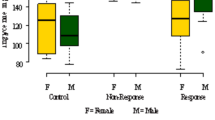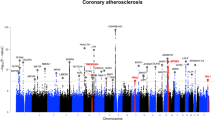Abstract
Hyperhomocysteinaemia has been identified as a risk factor for cerebrovascular, peripheral vascular and coronary heart disease1–4. Elevated levels of plasma homocysteine can result from genetic or nutrient-related disturbances in the trans-sulphuration or re-methylation pathways for homocysteine metabolism1,5–7. 5,10-Methylenetetrahydrofolate reductase (MTHFR) catalyzes the reduction of 5,10-methylenetetrahydrofolate to 5-methyltetra-hydrofolate, the predominant circulatory form of folate and carbon donor for the re-methylation of homocysteine to methionine. Reduced MTHFR activity with a thermolabile enzyme has been reported in patients with coronary and peripheral artery disease5,6. We have identified a common mutation in MTHFR which alters a highly-conserved amino acid; the substitution occurs at a frequency of approximately 38% of unselected chromosomes. The mutation in the heterozygous or homozygous state correlates with reduced enzyme activity and increased thermolability in lymphocyte extracts; in vitro expression of a mutagenized cDNA containing the mutation confirms its effect on thermolability of MTHFR. Finally, individuals homozygous for the mutation have significantly elevated plasma homocysteine levels. This mutation in MTHFR may represent an important genetic risk factor in vascular disease.
This is a preview of subscription content, access via your institution
Access options
Subscribe to this journal
Receive 12 print issues and online access
$209.00 per year
only $17.42 per issue
Buy this article
- Purchase on SpringerLink
- Instant access to full article PDF
Prices may be subject to local taxes which are calculated during checkout
Similar content being viewed by others
References
Boers, G.H.J. et al. Heterozygosity for homocystinuria in premature peripheral and cerebral ocelusive arterial disease. New Engl. J. Mod. 313, 709–715 (1985).
Genest, J.J. Jr., et al. Plasma homocysteine levels in men with premature coronary artery disease. J. Am. coll. Cartiiol. 16, 1114–1119 (1990).
Clarke, R. et al. Hyperhomocysteinemia: an independent risk factor for vascular disease. New Engl. J. Med. 324, 1149–1155 (1991).
Stampfer, M.J. et al. A prospective study of plasma homocysteine and risk of myocardial infarction in US physicians. J. Am. med. Assoc. 268, 877–881 (1992).
Kang, S.-S. et al. Thermolabile methylenetetrahydrofolate reductase: An inherited risk factor for coronary artery disease. Am. J. hum. Genet. 48, 536–645 (1991).
Engbersen, A.M.T. et al. Thermolabile 5,10-methylenetetrahydrofolate reductase as a cause of mild hyperhomocysteinaemia. Am. J. hum. Genet. 56, 142–150 (1995).
Selhub, J., Jacques, P.F., Wilson, P.W.F., Rush, D. & Rosenberg, I.H. Vitamin status and intake as primary determinants of homocysteinemia in an elderly population. J. Am. med. Assoc. 270, 2693–2698 (1993).
Rosenblatt, D.S. in The Metabolic Basis of Inherited Disease (eds Scriver, C.R., Beaudet, A.L, Sly, W.S. & Valle, D.) 2049–2064 (McGraw-Hill, New York, 1989).
Kang, S.-S., Passen, E.L., Ruggie, N., Wong, P.W.K. & Sora, H. Thermolabile defect of methytenetetrahydrofolate reductase in coronary artery disease. Circulation 88, 1463–1469 (1993).
Goyette, P. et al. Human methylenetetrahydrofolate reductase:isolation of cDNA, mapping and mutation identification. Nature Genet. 7, 195–200 (1994).
Goyette, P., Frosst, P., Rosenblatt, D.S. & Rozen, R. Seven novel mutations in the methylenetetrahydrofolate reductase gene andgenotype/phenotypecorrelations in severe methylenetetrahydrofolate reductase deficiency. Am. J. hum. Genet. 56, 1052–1059 (1995).
Daubner, S.C. & Matthews, R.G. Purification and properties of methylenetetrahydrofolate reductase from pig liver. J. biol. Chem. 257, 140–145 (1982).
Davies, J.F. . et al. Crystal structures of recombinant human dihydrofolate reductase complexed with folate and 5-deazafolate. J. Biochem. 29, 9467–3479 (1990).
Franken, D.G., Boers, G.H.J., Blom, H.J., Trijbels, J.M.F. & Kbppenborg, P.W.C. Treatment of mild hyperhomocysteinemia in vasculardisease patients. Arterioscler. Thromb. 14, 465–470 (1994).
Kang, S.S., Zhou, J., Wong, P.W.K., Kowalisyn, J. & Strokosch, G. Intermediate homocysteinemia: a thermolabile variant of methylenetetrahydrofolate reductase. Am. J. hum. Genet. 43, 414–421 (1988).
Horton, R.M. et al. Gene splicing by overlap extension. Meth. Enzymol. 217, 270–279 (1993).
Rosenblatt, D.S. & Erbe, R.W. Methylenetetrahydrofolate reductase in cultured human cells. I. Growth and metabolic studies. Pediatr. Res. 11, 1137–1141 (1977).
Author information
Authors and Affiliations
Rights and permissions
About this article
Cite this article
Frosst, P., Blom, H., Milos, R. et al. A candidate genetic risk factor for vascular disease: a common mutation in methylenetetrahydrofolate reductase. Nat Genet 10, 111–113 (1995). https://doi.org/10.1038/ng0595-111
Received:
Accepted:
Issue Date:
DOI: https://doi.org/10.1038/ng0595-111
This article is cited by
-
Congenital septal defects in Karachi, Pakistan: an update of mutational screening by high-resolution melting (HRM) analysis of MTHFR C677T
Human Genomics (2024)
-
Association between Psoriasis and MTHFR polymorphisms: a systematic review and meta-analysis
Archives of Dermatological Research (2024)
-
The combined effect of MTHFR C677T and A1298C polymorphisms on the risk of digestive system cancer among a hypertensive population
Discover Oncology (2024)
-
Dutch pharmacogenetics working group guideline for the gene-drug interaction of ABCG2, HLA-B and Allopurinol, and MTHFR, folic acid and methotrexate
European Journal of Human Genetics (2024)
-
New insights into the nutritional genomics of adult-onset riboflavin-responsive diseases
Nutrition & Metabolism (2023)



